Interventions for Clients with Fluid and Electrolyte imbalances
advertisement
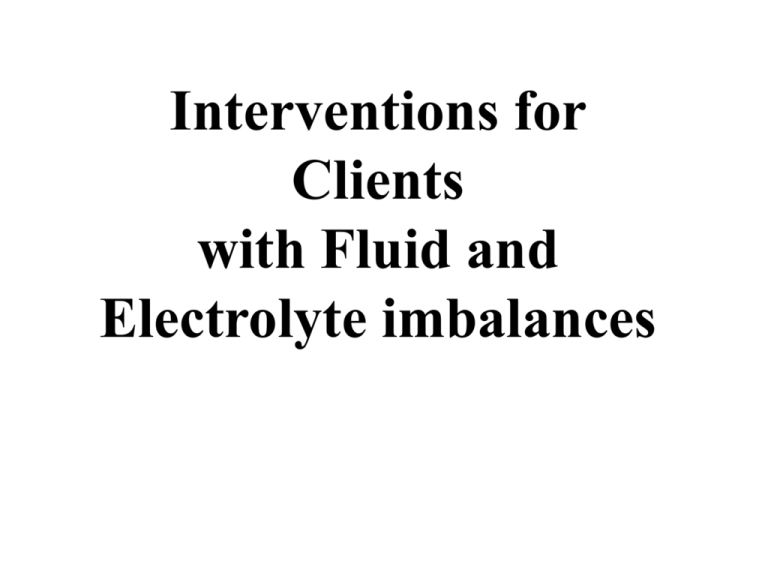
Interventions for Clients with Fluid and Electrolyte imbalances 2 Body Fluid Compartments • 2/3 (65%) of TBW is intracellular (ICF) • 1/3 extracellular water – 25 % interstitial fluid (ISF) – 5- 8 % in plasma (IVF intravascular fluid) – 1- 2 % in transcellular fluids – CSF, intraocular fluids, serous membranes, and in GI, respiratory and urinary tracts (third space) 3 4 5 • Fluid compartments are separated by membranes that are freely permeable to water. • Movement of fluids due to: – hydrostatic pressure – osmotic pressure\ • Capillary filtration (hydrostatic) pressure • Capillary colloid osmotic pressure • Interstitial hydrostatic pressure • Tissue colloid osmotic pressure 6 7 Balance • Fluid and electrolyte homeostasis is maintained in the body • Neutral balance: input = output • Positive balance: input > output • Negative balance: input < output 8 9 10 Solutes – dissolved particles • Electrolytes – charged particles – Cations – positively charged ions • Na+, K+ , Ca++, H+ – Anions – negatively charged ions • Cl-, HCO3- , PO43- • Non-electrolytes - Uncharged • Proteins, urea, glucose, O2, CO2 11 12 Regulation of body water • ADH – antidiuretic hormone + thirst – Decreased amount of water in body – Increased amount of Na+ in the body – Increased blood osmolality – Decreased circulating blood volume • Stimulate osmoreceptors in hypothalamus ADH released from posterior pituitary Increased thirst 13 14 Result: increased water consumption increased water conservation Increased water in body, increased volume and decreased Na+ concentration 15 Fluid Volume Excess Occurs when the body retains both water and sodium in similar proportions to normal ECF. It is also called hypervolemia. Common causes include:- Excessive intake of sodium chloride - Administering sodium-containing infusions too rapidly Disease processes that alter regulatory mechanisms such as heart failure, renal failure. Edema Excess interstitial fluid. Edema typically is most apparent in areas where the tissue pressure is low, such as around the eyes, and in dependent tissues (known as dependent edema), where hydrostatic capillary pressure is high. Pitting edema: edema that leaves a small depression or pit after finger pressure is applied to the swollen area. Electrolyte Imbalances Hyponatremia RISK FACTOR Assessments Nursing interventions -Monitor fluid losses and Loss of sodium, as in: Anorexia gains. Loss of GI .fluids Nausea and vomiting -Monitor for presence of GI and CNS symptoms. Use of diuretics Lethargy - Monitor serum Na levels. Gains of water, as in: Confusion - Check urine specific gravity. -If able to eat, encourage Excessive administration of Muscle cramps foods and fluids with high D5W Fingerprinting over sternum sodium content. -Be aware of sodium content Water intoxication Muscular twitching of common Disease states associated with Seizures -IV fluids. -Avoid giving large water SIADH (a form of Coma supplements to hyponatremia) Serum Na below 135 mEq/L -Patients receiving isotonic Pharmacologic agents that Urine specific gravity <1.010 tube feedings. -Take seizure precautions may impair water excretion when hyponatremia is severe Hypernatremia RISK FACTOR Assessments Nursing interventions - Monitor fluid losses and Water deprivation Thirst gains. Increased sensible and Elevated body temperature - Observe for excessive intake of high sodium foods. insensible water loss Tongue dry and swollen, - Monitor for changes in Ingestion of large amount of sticky mucous Membranes behavior such as restlessness, lethargy, and salt Severe hypernatremia disorientation. Excessive parenteral Disorientation - Look for excessive thirst and elevated body administration of sodiumHallucinations temperature. containing solutions Irritable and hyperactive - Monitor serum Na levels. Profuse sweating Focal or grand mal seizures - Check urine specific gravity. Diabetes insipidus Coma - Give sufficient water with Serum Na above 145 mEq/L tube feedings to Keep serum Na and BUN at normal Urine specific gravity limits. >1.015 Hypokalemia RISK FACTOR Diarrhea Vomiting or gastric suction Potassium-wasting diuretics Poor intake as in anorexia nervosa, alcoholism, potassiumfree parenteral .fluids Polyuria Assessments Fatigue Anorexia, nausea, and vomiting Muscle weakness Decreased bowel motility Cardiac arrhythmias Polyuria, nocturia, dilute urine Postural hypotension Serum K below 3.5 mEq/L ECG changes T waves flattening and ST segment depression on ECG Nursing interventions - Monitor for occurrence of Hypokalemia. - Prevent Hypokalemia by: - Encouraging extra K intake if possible - Educating about abuse of laxatives and diuretics -Administer oral K supplements if ordered. - Be knowledgeable about danger of IV potassium administration. Hyperkalemia RISK FACTOR Decreased potassium excretion: Oliguric renal failure Potassium-sparing diuretics High potassium intake, especially in presence of renal insufficiency Shift of potassium out of cells into the plasma (acidosis, tissue trauma, infection, burns) Assessments Vague muscle weakness Cardiac arrhythmias Paresthesias of face, tongue, feet, and hands Flaccid muscle paralysis GI symptoms such as nausea, intermittent intestinal colic, or diarrhea may occur Serum K above 5.0 mEq/L Peaked T waves, widened QRS on ECG Nursing interventions Monitor for hyperkalemia, which is life threatening. Prevent hyperkalemia by: Following rules for safe administration of K Avoiding giving patients with renal insufficiency K-saving diuretics, K supplements, or salt substitutes Cautioning about foods high in potassium content Hypocalcaemia RISK FACTOR Surgical hypoparathyroidism Malabsorption Vitamin D deficiency Acute pancreatitis Excessive administration of citrated blood Alkalotic states Assessments Trousseau’s and Chvostek’s signs Numbness and tingling of fingers and toes Mental changes Seizures Spasm of laryngeal muscles ECG changes Cramps in muscles of extremities Total serum calcium <8.5 mg/dL Nursing interventions Take seizure precautions when hypocalemia is severe. Monitor condition of airway. Take safety precautions if confusion is present. Educate people at risk for osteoporosis about need for dietary calcium intake. Discuss calcium-losing aspects of nicotine and alcohol use. Hypocalcemia Hypocalcemia A positive Trousseau's sign Muscular contraction including flexion of the wrist and metacarpophalangeal joints, hyperextension of the fingers and flexion of the thumb on the palm A positive Chvostek's sign. Twitching or contraction of the facial muscles produced by tapping on the facial nerve at specific point Hypercalcaemia RISK FACTOR Hyperparathyroidism Malignant neoplastic disease Prolonged immobilization Large doses of vitamin D Overuse of calcium supplements Thiazide diuretics Assessments Muscular weakness Tiredness, lethargy , Constipation Anorexia, nausea, and vomiting Decreased memory and attention span Polyuria and polydipsia Renal stones Cardiac arrest Serum calcium >10.5 mg/dL Nursing interventions Increase mobilization when feasible. Encourage sufficient oral intake. Discourage excessive consumption of milk products. Encourage bulk in the diet. Take safety precautions if confusion is present Be alert for signs of digitalis toxicity in Hypercalcaemia patients. Force fluids to prevent formation of renal stones. Hypercalcemia Hypomagnesemia Signs/symptoms Causes
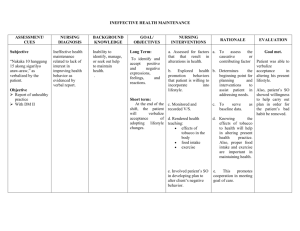
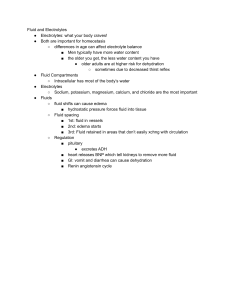




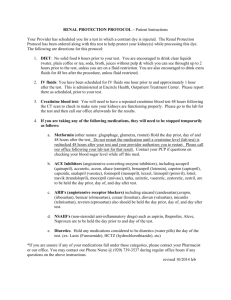

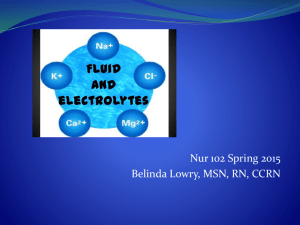



![Fluids_and_Electrolytes[1][1]](http://s3.studylib.net/store/data/009602181_1-340b41f5555e667c0a69d06db7449fa2-300x300.png)